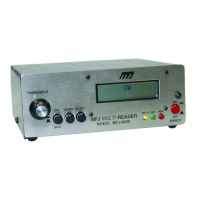
Do you have a question about the MFJ 462B MultiReader and is the answer not in the manual?
| Brand | MFJ |
|---|---|
| Model | 462B MultiReader |
| Category | Media Converter |
| Language | English |
Lists the supported operating modes: CW, RTTY, ASCII, AMTOR FEC.
Defines the frequency shifts for RTTY, ASCII, and AMTOR FEC modes.
Details mark frequencies for RTTY and specified baud rates for RTTY and ASCII.
Mentions printer compatibility and the 8000-character volatile RAM for messages.
Specifies the required 12 VDC power supply and connector type.
Describes the DB-25 printer port and the 3.5mm audio input jack.
Details connecting a hand key to the 3.5mm jack for CW code practice.
Explains jumper settings (J6, J7, J8) for US or European RTTY frequency shifts.
Guides powering on the unit, LED indicators, and the initial sign-on message.
Explains selecting signal type, baud rate, and tuning for proper decoding.
Lists the six main menu options: SIGNAL SETUP, BAUD RATE SETUP, etc.
Describes using the OPTION and SELECT buttons to navigate menu items.
Illustrates setting up for RTTY decoding by navigating through menu options.
Allows choosing the signal type to decode: CW, RTTY 170/425/850, ASCII, AMTOR FEC.
Explains how to initiate signal decoding and return to sub-menus.
Suggests switching to BAUD RATE SETUP for RTTY decoding issues.
Allows choosing the baud rate for RTTY signals (45, 50, 57, 75, 100 BAUD).
Controls printing of received text to an EPSON compatible printer.
Covers viewing, scrolling, printing, and clearing data stored in RAM.
Enables or disables the REVERSE mode for RTTY, ASCII, AMTOR FEC signals.
Enables or disables the practice mode for the CW hand key.
Guides tuning for CW reception and adjusting the THRESHOLD control.
Explains tuning for RTTY/ASCII/AMTOR FEC signals and tone settings.
Lists common abbreviations used in CW communication for quick reference.
Provides contact details for MFJ Technical Service and factory support.
